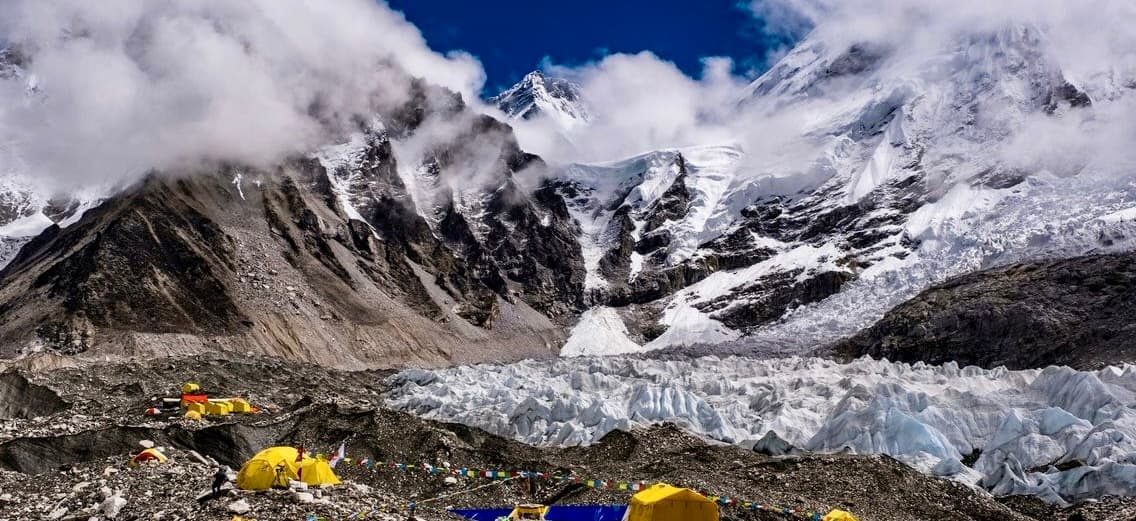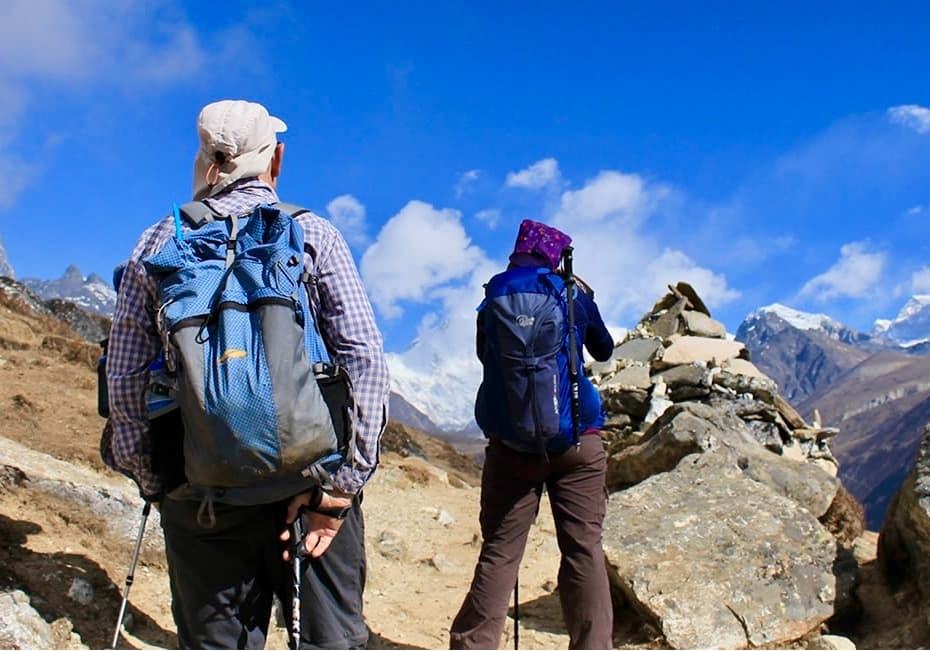Trekking in the Everest Region is an exhilarating yet challenging adventure that requires thorough preparation and an acute awareness of potential risks. At Luxury Holidays Nepal, we prioritize the safety and well-being of our trekkers, ensuring they are well-equipped with essential knowledge and support. Our comprehensive approach to Rescue and Evacuation During Everest Region Trekking encompasses a range of critical aspects. From Everest Trekking Safety Tips to High Altitude Rescue Operations, and Everest Region Emergency Evacuation protocols, we ensure every trekker is prepared for various scenarios. Understanding the importance of Helicopter Rescue in the Everest Trek and the nuances of Altitude Sickness Prevention and Treatment is crucial for a safe trekking experience. Our guides are well-versed in the dynamics of the Everest region, offering invaluable insight into Medical Facilities, Guide and Porter Services, and Acclimatization Strategies for Everest Trekking. Our commitment extends to providing comprehensive information on Everest Trekking Routes and Safety, maintaining effective Communications and Emergency Contacts, and keeping trekkers informed about Weather Conditions and Safety in Everest. We also assist with Trekking Permits and Regulations and encourage engagement with Local Villages and Support. Each aspect of our service is designed to ensure that our clients can enjoy the majestic beauty of Everest with confidence and security.
At Luxury Holidays Nepal, we pride ourselves on being the leading company in providing unparalleled services for Rescue and Evacuation During Everest Region Trekking. Our expertise and dedication to safety are unmatched, making us the best choice for adventurers seeking to explore the majestic Everest region. We understand the complexities and challenges of high-altitude trekking and are equipped with the knowledge, resources, and experience to handle any emergency situation effectively. Our team of seasoned professionals is trained in high-altitude rescue operations, ensuring a swift and efficient response when it matters most. We offer comprehensive support, from detailed pre-trek safety briefings to efficient emergency evacuation procedures, including helicopter rescue services. At Luxury Holidays Nepal, our commitment to your safety and well-being is unwavering, making us the most reliable and trusted partner for your Everest trekking adventure. Choose us for a journey where safety, expertise, and peace of mind are guaranteed, allowing you to fully immerse yourself in the awe-inspiring beauty of Everest.
Expertise in High-Altitude Rescue Operations
Rescue and Evacuation During Everest Region Trekking significantly revolves around Expertise in High-Altitude Rescue Operations. This expertise is crucial for addressing the unique challenges posed by the Everest region's rugged terrain and extreme altitudes.
-
Specialized High-Altitude Training: Our team is rigorously trained in high-altitude rescue operations, equipped with the skills necessary to navigate the harsh and unpredictable conditions of the Everest region.
-
Rapid Response Protocols: In high-altitude emergencies, every second counts. We have established rapid response protocols to ensure quick and effective action in critical situations.
-
Advanced Medical Knowledge: Understanding the complexities of altitude sickness and other high-altitude-related health issues is a cornerstone of our expertise. Our staff is trained in providing immediate medical assistance.
-
State-of-the-Art Equipment: Utilizing the latest in rescue technology and equipment, we are prepared for a range of emergency scenarios. This includes specialized gear for high-altitude navigation and communication.
-
Collaboration with Local Authorities: Our strong collaboration with local authorities and rescue services ensures a coordinated and efficient rescue operation, vital in remote and challenging environments.
-
Experience and Local Knowledge: Our team's extensive experience and profound local knowledge are invaluable in high-altitude rescue operations, enabling them to make quick and informed decisions.
-
Regular Drills and Updates: Regular drills and keeping up-to-date with the latest rescue techniques and guidelines are a part of our commitment to maintaining our high-altitude rescue capabilities.
-
Risk Assessment and Management: Prior to any trek, thorough risk assessments are conducted, and strategies are put in place to manage potential emergencies effectively.
-
24/7 Emergency Support: Our emergency support team is available around the clock, ready to respond to any crisis that may arise during the trek.
At Luxury Holidays Nepal, our Expertise in High-Altitude Rescue Operations is a fundamental aspect of our commitment to ensuring the safety and well-being of every trekker exploring the Everest region.
Altitude Sickness Prevention and Treatment
Rescue and Evacuation During Everest Region Trekking places a significant emphasis on Altitude Sickness Prevention and Treatment. We understand the criticality of addressing altitude sickness, a common challenge in high-altitude treks like those in the Everest region. Our approach encompasses both preventive measures and effective treatment strategies.
-
Pre-Trek Education and Awareness: We provide comprehensive education to our trekkers about the symptoms and risks of altitude sickness. This awareness is key to early detection and prevention.
-
Customized Acclimatization Schedules: Our itineraries are carefully planned to allow gradual acclimatization. We include rest days and ensure a gradual increase in altitude to reduce the risk of altitude sickness.
-
Monitoring Health Signs: Throughout the trek, our guides closely monitor the health of each trekker, paying attention to any signs of altitude sickness, and providing immediate assistance as needed.
-
Immediate Response to Symptoms: On detecting any signs of altitude sickness, our team is trained to provide immediate care, which may include administering oxygen, and medication, or initiating a descent to lower altitudes.
-
Access to Medical Advice: We ensure that trekkers have access to professional medical advice, either through our trained guides or via communication with medical professionals.
-
Provision of Necessary Medications: We equip our guides with necessary medications for the treatment of mild altitude sickness, ensuring that prompt medical response is available.
-
Evacuation Readiness for Severe Cases: In cases of severe altitude sickness, our evacuation plan is swiftly put into action, prioritizing the affected trekker's immediate descent and medical care.
-
Regular Health Checks: Conducting regular health checks helps in the early detection of any health issues, including symptoms of altitude sickness.
-
Promoting Hydration and Proper Nutrition: We emphasize the importance of staying hydrated and maintaining a balanced diet, which is crucial in preventing altitude sickness.
-
Ensuring Adequate Rest and Sleep: Proper rest and sleep are vital in altitude sickness prevention. Our itineraries are designed to ensure trekkers get enough rest.
By prioritizing Altitude Sickness Prevention and Treatment, Luxury Holidays Nepal ensures that trekkers can safely enjoy their journey in the Everest region, with minimized risks and a focus on their health and well-being.
Communication and Coordination
Rescue and Evacuation During Everest Region Trekking heavily relies on effective Communication and Coordination. We recognize that maintaining clear and consistent communication channels and coordinating efficiently among various parties is vital for the safety and well-being of trekkers in the Everest region.
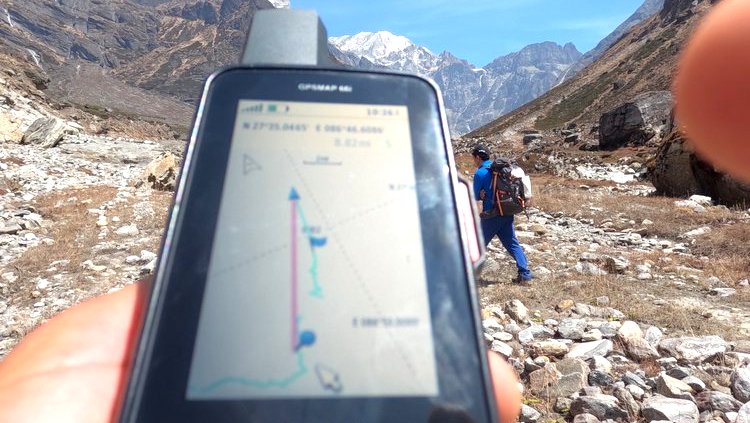
-
Advanced Communication Equipment: We equip our trekking teams with state-of-the-art communication devices, including satellite phones and radios, ensuring connectivity even in remote areas.
-
Regular Check-Ins and Updates: Our guides perform regular check-ins with our base office, providing updates on the trekking group’s progress, weather conditions, and any emerging issues.
-
Emergency Contact Protocols: We have established protocols for emergency situations, ensuring swift communication between the trekking team, rescue services, medical facilities, and the relevant authorities.
-
Coordination with Local Authorities and Rescue Teams: Strong relationships with local authorities, rescue teams, and healthcare providers in the Everest region allow for efficient coordination during emergencies.
-
Training in Emergency Communication: Our guides and support staff receive thorough training in emergency communication, ensuring they know how to effectively convey critical information during a crisis.
-
Informing Trekkers about Communication Protocols: We brief our clients on communication protocols, providing them with emergency contact numbers and information on how to reach out in case of an emergency.
-
Collaboration with Helicopter Rescue Services: In case of serious emergencies that require rapid evacuation, we coordinate with helicopter rescue services for timely and efficient operations.
-
Centralized Coordination System: Our centralized coordination system ensures that all information and actions are streamlined and managed effectively from our base office.
-
Multi-Lingual Support: Recognizing the diverse backgrounds of our trekkers, we offer multi-lingual support to facilitate clear communication without language barriers.
-
Family and Embassy Contact in Emergencies: In the event of an emergency, we take responsibility for contacting the trekker’s family and, if necessary, their embassy, providing updates and coordinating support.
By prioritizing Communication and Coordination, Luxury Holidays Nepal ensures a well-organized, safe, and responsive trekking experience in the Everest region, ready to effectively handle any emergency situations that may arise.
Acclimatization Strategies
Rescue and Evacuation During Everest Region Trekking greatly benefit from effective Acclimatization Strategies. We understand that proper acclimatization is key to minimizing the risks associated with high-altitude trekking, including altitude sickness. Our strategies are designed to help trekkers adapt safely to the high elevations in the Everest region.
-
Gradual Altitude Gain: Our trekking itineraries are carefully planned to ensure a gradual increase in altitude. This allows trekkers' bodies to adjust to the lower oxygen levels at higher elevations, reducing the risk of altitude sickness.
-
Rest Days for Acclimatization: We incorporate rest days into our trekking schedules. These are not just for relaxation but are critical for allowing trekkers' bodies to acclimatize naturally.
-
Hydration and Nutrition: Emphasizing the importance of staying well-hydrated and consuming a balanced diet, we guide our trekkers on the best practices for maintaining health at high altitudes.
-
Regular Health Monitoring: Our guides conduct regular health checks, monitoring for symptoms of altitude sickness. Early detection is crucial for timely treatment or descent.
-
Educating Trekkers on Altitude Sickness: Before and during the trek, we educate our clients about the symptoms of altitude sickness, its prevention, and the importance of communicating any health concerns immediately.
-
Avoiding Rapid Ascent: We avoid itineraries that involve a rapid ascent, as this significantly increases the risk of developing altitude sickness.
-
Flexible Itineraries: Our itineraries are flexible, allowing for additional rest days or a slower ascent if needed, based on the group's acclimatization and overall health.
-
Medication and Oxygen Supplies: While medication is not a substitute for proper acclimatization, we carry altitude sickness medication and portable oxygen for emergencies.
-
Encouraging Proper Rest and Sleep: Adequate rest and sleep are vital for acclimatization. Our trek schedules ensure that trekkers get enough downtime.
-
Climb High, Sleep Low: Whenever possible, our itineraries follow the 'climb high, sleep low' principle, where trekkers ascend to higher altitudes during the day but return to lower altitudes to sleep.
By implementing these Acclimatization Strategies, Luxury Holidays Nepal enhances the safety and enjoyment of Everest trekkers, reducing the risk of altitude-related complications and ensuring a memorable and successful trekking experience.
Weather Monitoring and Advisories
Rescue and Evacuation During Everest Region Trekking is significantly influenced by Weather Monitoring and Advisories. We understand that weather in the Everest region can be unpredictable and can change rapidly, impacting trekking conditions and safety. Therefore, we place a high priority on continuously monitoring weather conditions and providing timely advisories to our trekkers.
-
Advanced Weather Forecasting Tools: We utilize sophisticated weather forecasting tools and services to stay updated on the latest weather conditions in the Everest region.
-
Regular Weather Updates to Trekking Teams: Our trekking teams receive regular updates on the weather, which helps in planning the day's activities and making necessary adjustments to the itinerary.
-
Training Guides in Weather Assessment: Our guides are trained in understanding and interpreting weather patterns and signs, enabling them to make informed decisions on the ground.
-
Pre-Trek Weather Briefings: Before embarking on the trek, we provide detailed briefings to our clients on the expected weather conditions, preparing them for what to expect.
-
Emergency Protocols for Adverse Weather: In case of adverse weather conditions, such as heavy snowfall, avalanches, or storms, we have established emergency protocols to ensure the safety of our trekkers, including possible evacuation.
-
Flexible Itineraries to Accommodate Weather Changes: Our trekking itineraries are flexible, allowing us to adjust plans in response to weather advisories, ensuring the safety and comfort of our clients.
- Collaboration with Local Meteorological Services: We maintain close contact with local meteorological services for accurate and timely weather information.
-
Educating Trekkers on Weather-Related Safety: We educate our clients on how to stay safe in different weather conditions, including the proper use of trekking gear and the importance of adhering to weather advisories.
-
Immediate Response to Weather Emergencies: In the event of a weather emergency, our team is prepared to respond immediately, ensuring the quick and safe evacuation of trekkers if needed.
Through diligent Weather Monitoring and Advisories, Luxury Holidays Nepal ensures that trekkers are well-informed and prepared for the varying weather conditions of the Everest region, significantly enhancing the safety and success of their trekking experience.
Helicopter Rescue Services
Rescue and Evacuation During Everest Region Trekking often involves the critical component of Helicopter Rescue Services, a vital aspect of the emergency response system in the challenging terrain of the Everest region. We place a significant emphasis on this service to ensure the highest level of safety and rapid response in case of emergencies. Here's an overview of how helicopter rescue services are integrated into our rescue and evacuation plan:
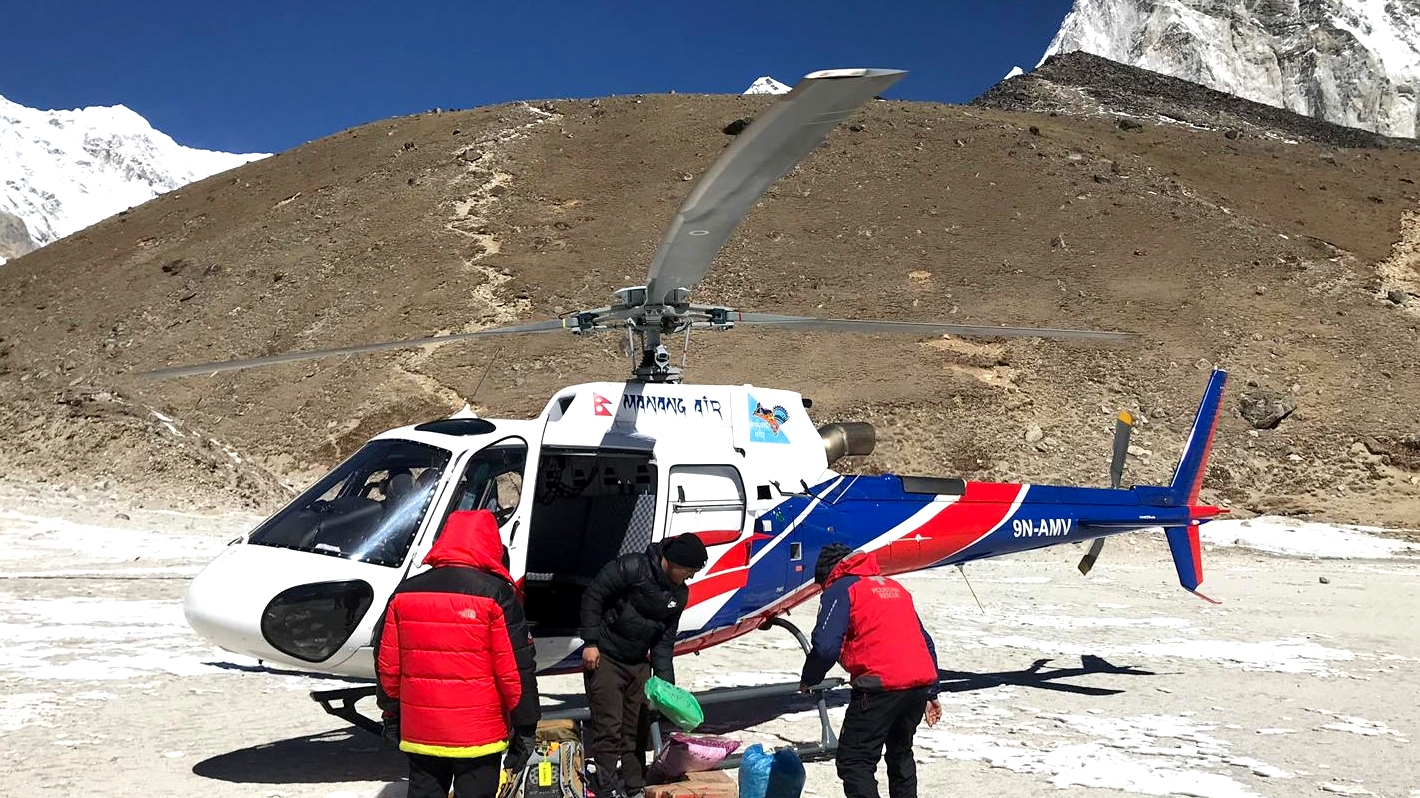
-
Strategic Partnerships with Helicopter Companies: We maintain strong partnerships with reputable helicopter companies specialized in high-altitude operations, ensuring prompt and reliable air rescue services.
-
Rapid Deployment for Emergency Evacuation: In case of severe altitude sickness, injuries, or other critical health issues, we can quickly coordinate helicopter evacuation to transport affected trekkers to medical facilities.
-
Equipped for High-Altitude Operations: The helicopters used are equipped for high-altitude flights and manned by pilots experienced in navigating the challenging Himalayan terrain.
-
Coordination with Medical Facilities: During a helicopter rescue, coordination with medical facilities ensures that necessary preparations are made for immediate medical attention upon the trekker’s arrival.
-
Weather Dependent Operations: Helicopter rescues are subject to weather conditions in the Everest region. We continuously monitor weather forecasts to identify safe windows for flight operations.
-
Insurance Verification: We assist trekkers in verifying their insurance coverage for helicopter rescue to ensure clarity on coverage and avoid financial complications.
-
Training in Helicopter Safety and Protocols: Our guides and trekkers are briefed on helicopter safety and protocols to ensure smooth operations during an evacuation.
-
Communication and Coordination: Effective communication channels are maintained with helicopter services for timely dispatch and accurate information sharing during the rescue process.
-
24/7 Readiness for Emergencies: Helicopter rescue services are on standby to respond to emergencies around the clock, ensuring no delay in critical situations.
-
Integration with Overall Safety Strategies: Helicopter rescues are part of a broader safety strategy that includes regular health monitoring, acclimatization checks, and emergency response planning.
The inclusion of Helicopter Rescue Services in our rescue and evacuation strategy underscores Luxury Holidays Nepal’s commitment to providing a safe and secure trekking experience in the Everest region. It ensures that trekkers have access to immediate and effective rescue solutions, significantly enhancing the safety of their Himalayan adventure.
Community Engagement and Local Support
Rescue and Evacuation During Everest Region Trekking is significantly enhanced by Community Engagement and Local Support. We understand the vital role local communities play in ensuring the safety and success of treks in the Everest region. Engaging with these communities and garnering their support forms a fundamental part of our rescue and evacuation strategies.
-
Building Relationships with Local Villages: We have established strong relationships with local villages along the trekking routes. These communities can provide essential support in emergencies, from offering shelter to assisting in search and rescue operations.
-
Leveraging Local Knowledge: Local residents possess invaluable knowledge about the terrain, weather patterns, and potential hazards in their areas. This knowledge is crucial for planning safe treks and responding effectively to emergencies.
-
Supporting Local Emergency Responders: We collaborate with local emergency responders, who are often the first on the scene in the event of an incident. Their proximity and familiarity with the region make them indispensable in rescue operations.
-
Training and Empowering Local Teams: We contribute to training local guides, porters, and other community members in basic first aid and rescue techniques, enhancing the overall safety net available to trekkers.
-
Community-Based Communication Networks: In areas where technological communication is limited, we rely on community-based networks to relay messages and coordinate responses in emergencies.
-
Cultural Sensitivity and Respect: Our interactions with local communities are grounded in cultural sensitivity and respect. This approach fosters mutual trust and cooperation, which is essential in emergency situations.
-
Local Resource Utilization: In rescue operations, we utilize local resources, including manpower, knowledge, and infrastructure, ensuring a swift and efficient response.
-
Economic Support to Local Communities: By engaging local services and purchasing local goods, we contribute to the local economy, strengthening the community and fostering a supportive relationship.
-
Regular Community Engagement Activities: We conduct regular community engagement activities to understand their needs and perspectives, which helps in building a robust support system for our treks.
-
Feedback and Continuous Improvement: We seek feedback from local communities on how to improve our trekking operations and emergency response strategies, ensuring they are effective and beneficial for all involved.
The role of Community Engagement and Local Support in Rescue and Evacuation During Everest Region Trekking is pivotal. It not only enhances the safety and responsiveness of our operations but also contributes to the sustainable and responsible development of trekking in the Everest region.
Availability of Medical Facilities and Support
Rescue and Evacuation During Everest Region Trekking greatly benefits from the Availability of Medical Facilities and Support. We understand the importance of accessible medical care in remote trekking areas like Everest. Our approach ensures that trekkers have the necessary medical support throughout their journey.
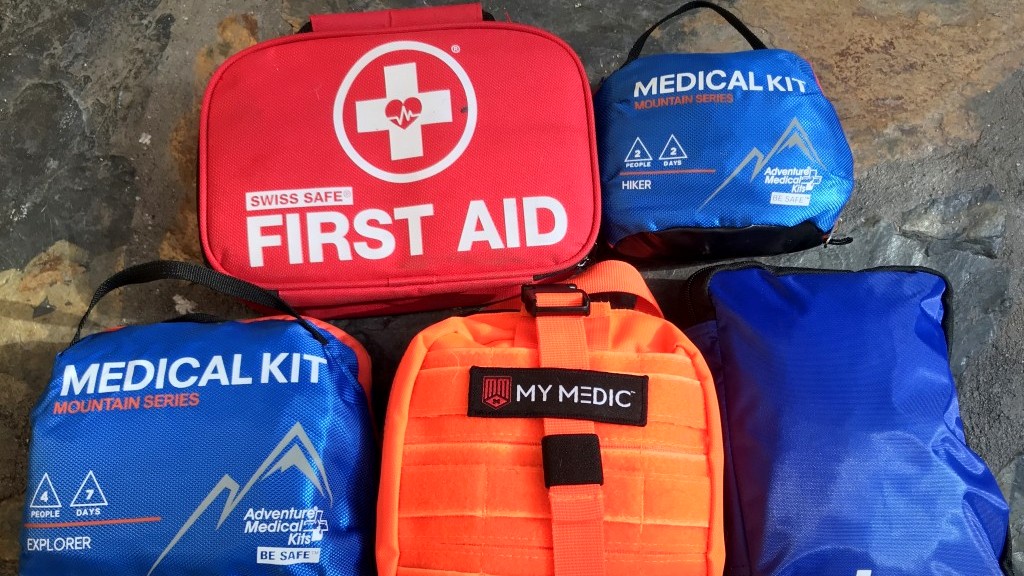
-
Information on Nearest Medical Facilities: We provide detailed information about the location and services of the nearest medical facilities along the trekking routes. This knowledge is crucial for quick access in case of emergencies.
-
First-Aid Trained Guides and Porters: Our guides and porters are trained in first aid and carry essential medical supplies. They are prepared to provide immediate assistance and make informed decisions about seeking further medical care.
- Regular Health Monitoring: Our team conducts regular health checks to monitor the well-being of trekkers, paying special attention to symptoms of altitude sickness or other health issues.
-
Emergency Medical Evacuation Plans: In cases where advanced medical care is needed, we have emergency evacuation plans, including helicopter rescue, to transport trekkers to well-equipped medical facilities.
-
24/7 Assistance and Coordination: Our support team is available around the clock to coordinate medical assistance and evacuation if necessary, ensuring no time is lost in critical situations.
-
Medical Kits and Supplies: We equip our trekking teams with comprehensive medical kits that include medications and supplies for treating common ailments and injuries encountered during the trek.
-
Access to Remote Medical Consultation: Where possible, we facilitate remote medical consultations, allowing trekkers to receive professional medical advice even in remote locations.
-
Insurance Liaison for Medical Emergencies: We assist trekkers in liaising with their travel insurance providers for coverage of medical emergencies, ensuring a smooth process for receiving medical care.
-
Training in High-Altitude Health Risks: Our team is continually trained and updated on the specific health risks associated with high-altitude trekking, enabling them to provide informed support and care.
The Availability of Medical Facilities and Support provided by Luxury Holidays Nepal is integral to our commitment to the safety and well-being of our clients, ensuring they have a safe and enjoyable trekking experience in the Everest region.
Insurance
Rescue and Evacuation During Everest Region Trekking greatly emphasizes the importance of having appropriate Insurance. We strongly advise all trekkers to obtain comprehensive insurance coverage that specifically includes high-altitude trekking and emergency evacuation. This insurance is not just a safety net but a crucial component of trekking preparation.
-
Coverage for High-Altitude Trekking: We recommend insurance policies that specifically cover activities up to the altitudes involved in Everest region trekking. Standard travel insurance often does not cover high-altitude treks.
-
Emergency Evacuation Coverage: Given the remote nature of the Everest region, emergency evacuation, especially by helicopter, can be extremely costly. Insurance that covers such evacuations is essential.
-
Medical and Hospitalization Benefits: In the event of altitude sickness or other medical emergencies, having insurance that covers medical treatment and hospitalization is vital.
-
Assistance with Insurance Claims: Our team assists clients in understanding their insurance coverage and provides necessary documentation and support in case they need to make a claim.
-
Advice on Selecting the Right Insurance Policy: We provide guidance to our clients on choosing the right insurance policy that meets the specific requirements of trekking in the Everest region.
-
Trip Cancellation and Interruption Coverage: We advise on obtaining insurance that covers trip cancellations or interruptions due to unforeseen circumstances, ensuring financial protection.
-
Personal Liability and Accident Coverage: Insurance that includes personal liability and accident coverage provides an additional layer of security for trekkers.
-
Information on Local Health Care System: We provide information on the local healthcare system in the Everest region and how it interacts with various insurance policies.
- Regular Updates on Insurance Requirements: We keep ourselves updated on the changing requirements and recommendations for insurance in the Everest region and communicate this to our clients.
Having the right Insurance for Rescue and Evacuation During Everest Region Trekking is not just about compliance but about ensuring peace of mind, allowing trekkers to fully immerse themselves in the beauty and challenge of the Everest trek with the assurance of safety and support.
Luxury Everest Region Trekking
Luxury Everest Region Trekking, offered by Luxury Holidays Nepal, is a unique and upscale experience designed for those who wish to explore the majestic Everest region without compromising on comfort and exclusivity. This luxury trekking experience combines adventure with top-notch services and amenities, ensuring a memorable journey through one of the world's most spectacular landscapes.
Key Features of Luxury Everest Region Trekking
-
Premium Accommodation: Stay in the best lodges or luxury tented camps throughout the trek. These accommodations provide superior comfort, often with amenities like heated rooms, en-suite bathrooms, and quality bedding.
-
Gourmet Dining: Enjoy gourmet meals prepared by professional chefs, featuring a mix of local and international cuisine. Dietary preferences and restrictions are catered to with utmost care.
-
Small Group Size: To ensure personalized attention and an intimate experience, luxury treks are typically conducted in small groups.
-
Expert Guides and Porters: Be guided by experienced and knowledgeable professionals who not only ensure a safe journey but also enrich your trek with insights into the local culture, history, and environment.
-
Private Transfers and Helicopter Options: Benefit from private ground transfers and the option for helicopter flights, either for scenic tours or for bypassing tougher trekking sections.
-
Exclusive Experiences: Gain access to exclusive experiences, such as private cultural performances, meetings with local dignitaries, or visits to secluded monasteries.
-
Wellness and Relaxation: Some packages include wellness and relaxation elements like massages, yoga sessions, or meditation classes, perfect after a day of trekking.
-
Customizable Itineraries: The itineraries are flexible and can be tailored to meet your preferences, fitness levels, and interests.
- Sustainable and Responsible Travel: Commitment to sustainable practices, ensuring minimal environmental impact and support for local communities.
Typical Itinerary Highlights
- Lukla Flight: Experience the thrilling flight to Lukla, the gateway to Everest.
- Namche Bazaar: Explore this bustling Sherpa town, often a rest and acclimatization stop.
- Tengboche Monastery: Visit this iconic monastery with stunning views of Everest.
- Everest Base Camp: For those who choose, the trek to Everest Base Camp is a highlight.
- Kala Patthar: Climb to this viewpoint for the best views of Everest.
- Luxury Amenities: Enjoy evenings in comfort, with fine dining and relaxation.
Embarking on a Luxury Everest Region Trekking adventure with Luxury Holidays Nepal means experiencing the Everest region in a way that is both exhilarating and comfortable, making for an unforgettable journey in the heart of the Himalayas.
FAQs: Rescue and Evacuation During Everest Region Trekking
Q: What is the process for emergency evacuation during the Everest trek?
A: In case of an emergency, we initiate our evacuation process which includes immediate assessment by our trained guides, coordination with local authorities for ground support, and, if necessary, arrangement of helicopter evacuation to the nearest medical facility.
Q: How are high-altitude emergencies like altitude sickness handled?
A: Our guides are trained to recognize and respond to symptoms of altitude sickness. The first step is usually to descend to a lower altitude. We also carry basic medical supplies and have protocols for more severe cases, which may include evacuation for medical treatment.
Q: Are your guides and porters trained for emergency situations?
A: Yes, our guides and porters are thoroughly trained in first aid, emergency response, and high-altitude rescue operations. They are well-equipped to handle a range of emergency situations.
Q: Is a helicopter rescue available during the trek?
A: Yes, we have provisions for helicopter rescue in case of severe emergencies. This service is subject to weather conditions and the trekker's insurance coverage.
Q: How important is it to have trekking insurance for the Everest trek?
A: It is extremely important to have comprehensive trekking insurance that covers high-altitude trekking and emergency evacuation. This ensures that you are financially covered in case of emergencies, including helicopter rescues.
Q: How do you communicate in case of an emergency?
A: We use satellite phones and other communication devices to stay in touch with our base, local authorities, and rescue services. This ensures effective communication even in remote areas of the trek.
Q: What medical facilities are available in the Everest region?
A: The Everest region has several health posts and clinics, especially in larger villages like Namche Bazaar. However, these facilities have limited resources, emphasizing the importance of evacuation arrangements for serious medical issues.
Q: What role do local communities play in rescue operations?
A: Local communities are vital in rescue operations, offering ground support, local knowledge, and manpower. We have strong relationships with these communities, which can be crucial in emergency situations.
Q: How do you ensure trekkers' safety during adverse weather conditions?
A: We closely monitor weather forecasts and conditions. In case of adverse weather, we may alter the trekking route, delay, or halt the trek, or in extreme cases, initiate evacuation procedures.
Q: Can the trek itinerary be changed in case of an emergency?
A: Yes, we maintain flexible itineraries and can make necessary adjustments, including changes in route or duration, in response to emergencies or as per the trekker's health conditions.
If you need any further information, please contact us by email: at [email protected], Phone: at +977- 985 100 5129 (WhatsApp)

